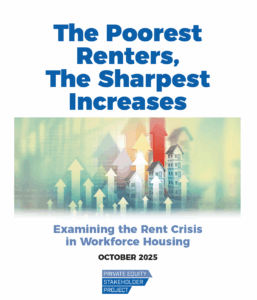
The Poorest Renters, the Sharpest Increases: Examining the Rent Crisis in Workforce Housing
October 21, 2025
To download a PDF version of this report, click here.
Key takeaways
- From 2021 to 2025, there was more than a 20% increase in rents at workforce housing apartments, the lowest-rent sector of market-rate housing (housing where tenants do not receive government subsidies). This type of affordable unsubsidized housing is the primary form of shelter for poor renters in the United States, two thirds of whom receive no federal housing assistance following decades of program cuts.
- The rent increase at workforce housing was more than double the 9.2% increase during this same period for “discretionary” housing – housing for renters with substantial incomes who are generally capable of purchasing a home.
- At the regional level, the majority of regions saw workforce housing rent increases over 20% from 2021 to 2025. The most significant regional increases were in Florida (26.8%), the Northeast (25.3%), and the Pacific Northwest (23.2%).
- Of the 94 rental markets we analyzed, more than two thirds of these marketssaw workforce housing cost increases that surpassed 15%,and only five markets saw workforce housing rent increases below 10%.
- In contrast, rents for “discretionary” renters did not increase nearly as much.
- In all but three of the country’s thirteen regions, rent increases for workforce housing were at least twice that of discretionary housing. In the Southeast, workforce rents increased 7.3 times more than discretionary rents.
- Only a quarter of the 94 markets we reviewed saw discretionary housing rent increases over 15%, contrasting with two thirds of markets for workforce housing.
- Of the 20 locations with the largest disparities between workforce and discretionary rent increases, all but four are located in the Sunbelt region.
- Out of the 94 markets sampled, there were only 11 markets where rent increases for high income tenants outpaced rent increases for low income tenants.
- Investor landlords, including private equity firms, look towards workforce housing as a relatively consistent source of profit during tough economic times. Investor materials clearly express that workforce tenants are a reliable and captive renter class due to the massive demand for accessible housing.
- While evictions already had reached a state of profound crisis for poor tenants in America prior to the COVID pandemic, the past four years’ rent increases in workforce housing communities are likely to lead to increased eviction filings as well as increased self eviction (when tenants proactively move in response to rent increases).
- Some workforce housing properties change hands frequently, with corporate landlords transferring ownership every 2 to 4 years, often selling at much higher prices than the purchase price.
- The federal Government Sponsored Enterprises (GSEs) Fannie Mae and Freddie Mac help provide easy loan financing to landlords of workforce properties. More tenant protections are needed to ensure that the GSEs deliver on their stated mission of increasing affordability in the workforce housing space.
- Common sense policy interventions are urgently needed to reduce harms to tenants of workforce housing, including price controls, eviction protections, institutional investment standards, and creating alternative avenues for community controlled housing.
Rents in the United States, already high prior to the onset of pandemic-related economic shifts, have become downright unmanageable for most of the country’s residents in 2025. With multifamily rents rising by a total of 13 percent over the past four years, most people who work to earn their living are feeling the squeeze. However, exactly how fast one’s rent has gone up largely is correlated with one’s class status, with the poorest tenants experiencing much more significant increases in rent despite having the least amount of savings to spare. From 2021 to 2025, workforce housing rents increased at 2.2 times the rate of discretionary housing rents (AKA luxury rents).
“Workforce housing” is a term that varies in meaning depending on who’s using it. While some definitions associate workforce housing with middle class “grey collar” professions like teachers and first responders, others understand workforce housing to be targeted towards workers in historically low wage industries. In this report, workforce housing refers to the lowest rent housing that exists without government subsidies, occupied by workers who earn low wages but cannot access assistance through programs like Section 8 or the Low Income Housing Tax Credit (LIHTC). According to classifications from the national multifamily property database Yardi Matrix, the workforce housing sector in the United States comprises more than five million class C and D apartments. This report looks at a segment of these workforce apartment units, investigating rent prices trends, investor behavior, and eviction dynamics within the workforce housing sector. While investors have historically tended to favor luxury housing, it becomes clear that workforce housing is a sector that is increasingly being used by investors to turn a profit with little benefit to tenants.
Note: This report was corrected on November 14, 2025. Tara Hill apartments was erroneously identified as located in Gwinnett County. The correction changed Gwinnett County to Clayton County, and county eviction data was updated to reflect figures for Clayton County.
Read the full report >>

